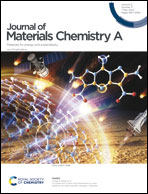Hydrazide and amidoxime dual functional membranes for uranium extraction from seawater†
Abstract
Amidoxime (AO)-based adsorbents are currently regarded as the most promising materials for extracting uranium (U) from seawater, but have limited adsorption capacities. To overcome this challenge, there is an urgent need to develop novel extraction groups with multifunctional capabilities such as adsorption and reduction. In this study, we proposed for the first time to introduce hydrazide groups with reduction and chelation functionalities into adsorbent materials. These groups were integrated into poly(ethylene)–poly(amidoxime) membranes creating a two-in-one bifunctional structure with adsorption and reduction to enhance uranium extraction from seawater. Our results showed that the adsorption capacity of the hydrazide-functionalized materials in uranyl solution increased by 22%, indicating that it has excellent adsorption properties. Following a 30-day adsorption experiment conducted in natural seawater, the uranium adsorption capacity reached a notable 6.76 mg-U/g-ads. Additionally, XPS analysis demonstrated that uranyl ions were adsorbed in the hydrazide-functionalized materials and were reduced to their low-valence state during adsorption, from U(VI) to U(IV). The adsorbents, with dual reduction/chelation effects, provide new insights and possibilities for designing novel uranium adsorbents for future uranium extraction from seawater.



 Please wait while we load your content...
Please wait while we load your content...